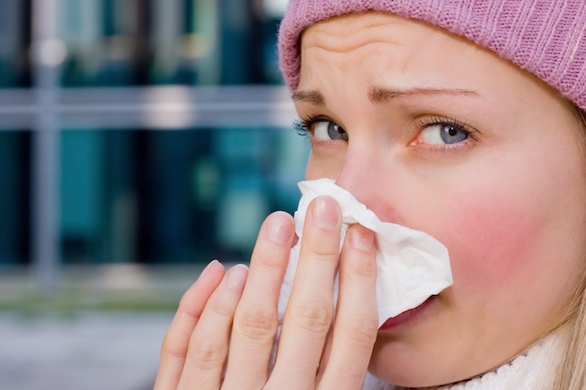A hundred years ago, doctors might have called it “coryza.” Today, they speak of URI (upper respiratory infection) or viral rhinitis. You probably call it the common cold. Any way you label it, though, you’re in for five to ten days of sniffling, sore throat, and miserable fatigue.
Why “cold”? Before the dawn of our understanding of infectious organisms, people thought that cold weather caused these symptoms. It wasn’t until the 1950s that scientists first identified the viruses that actually cause cold. Since then, over 200 different types of virus that can cause it have been identified – that’s why the cold is so common!
Even with our understanding of its infectious origins, it’s still clear that the cold is much more common during cold winter weather. The most frequent explanation for this has been that people spend more time indoors in close quarters in the winter. However, in our modern world, people spend much more time indoors year-round, yet the winter prevalence remains.
There are several factors that can explain this phenomenon:
- Cold air and indoor dry air (think furnaces) carry droplets of coughs and sneezes much farther and more easily.
- The shell of the influenza virus gets tougher in cold weather, making it hardier and easier to spread.
- The hairs and mucus in our nose have a harder time stopping germs when it’s cold.
- The rhinovirus (the most common type of cold virus) reproduces more easily in cold weather.
One thing most people don’t think about is that most of the symptoms of the cold are actually caused by our immune system fighting off the virus, not the virus itself. And our bodies have an amazing adaptation to those viral factors listed above: our genes that control inflammation are actually expressed at much higher rates in the winter than in the summer. This is great to combat those more aggressive viruses, but it also explains the symptoms we experience. This is another step in the field of epigenetics: our modern understanding that while our DNA does not change, the way that DNA is expressed does.
Know that it’s not your imagination or superstition that we get colds more frequently in the winter. And it’s worth reiterating the natural steps we can take to prevent and treat URIs that I wrote about last month:
- Frequent hand-washing: remember, it does not need to be antibacterial soap (the common cold is caused by viruses, not bacteria). Just scrub your hands thoroughly for at least 20 seconds.
- Ensure good vitamin D status: Studies have found that individuals with low levels of vitamin D are more susceptible to flu. A supplement of vitamin D3 (the active form), 2000-5000 IU daily, is a cheap and safe insurance policy through the winter months.
- Don’t skimp on sleep: This is often the “forgotten” foundation of health from a naturopathic viewpoint, because it’s not sexy. But turning off the electronic screens and getting your 7-9 hours of sleep per night is one of the main things you can do to boost your immune system.
- Get extra herbal support when needed: If you’re around a lot of people with upper respiratory illnesses, try beta-glucan rich immune boosters like WholeMune by Ortho Molecular Products. If you get a cold or the flu, load up on andrographis, elderberry, echinacea, vitamin C, and zinc. The keys are to start early (at the first sign of a sniffle or a tickle in your throat), and to dose frequently (every two hours while awake for the first two days). The combo I most often recommend for this is Viracid by Ortho Molecular.


